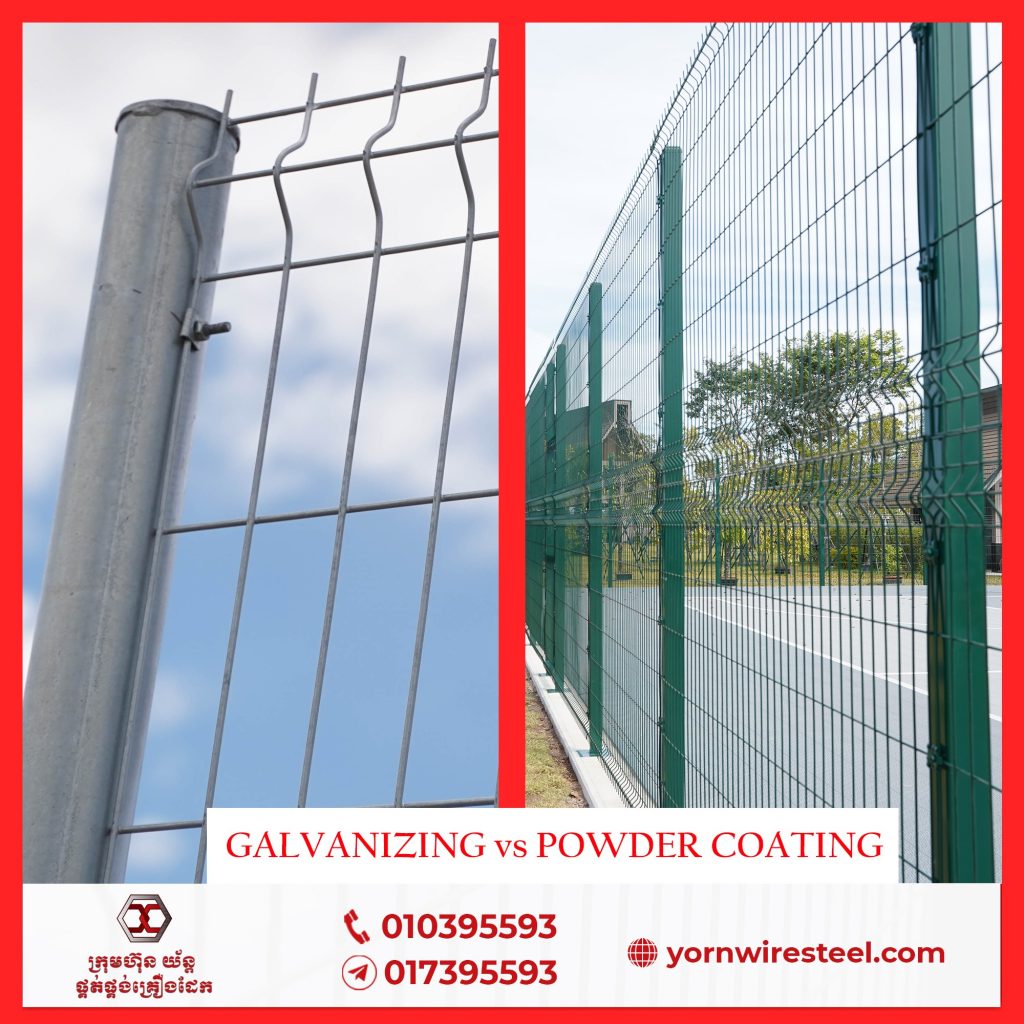Galvanizing OR Powder Coating?
Have you ever wondered which one is suitable for your projects, between galvanizing and powder coating of wire steel? Please read below for more info for you to make better decision between these 2 coating.

ប្រៀបធៀប ការស្រោបស័ង្កសីក្តៅ និង ការស្រោបម្សៅចំហុយ លើរបងសំណាញ់ផ្សារ
ការស្រោបស័ង្កសីក្តៅ និងការស្រោបម្សៅចំហុយ អាចផ្តល់ការការពារ និងលើកកំពស់រូបរាងនៃរចនាសម្ព័ន្ធផ្សេងៗបានដូចគ្នា។
ទោះជាយ៉ាងណាក៏ដោយ ពួកវាខុសគ្នានៅក្នុងលក្ខខណ្ឌ នៃដំណើរការថ្នាំកូត ភាពធន់ ការថែទាំ និងដំណើរការទាំងមូល។
ខាងក្រោមនេះជាការប្រៀបធៀបរវាងការស្រោបទាំងពីរ៖
– របងដែលស្រោបស័ង្កសីក្តៅ៖ របងប្រភេទនេះត្រូវបានស្រោបដោយជ្រមុជវាក្នុងទឹកស័ង្កសីរលាយ។ ចំណងរវាង ស័ង្កសីនឹង ដែកដែលបង្កើតជាស្រទាប់ក្រាស់មួយ ហើយជាប់បានយូរ។
– របងដែលស្រោបដោយម្សៅ៖ នៅក្នុងដំណើរការនេះ ម្សៅពណ៌ដែលស្ងួតត្រូវបានបាញ់ ដោយអេឡិចត្រូស្តាតទៅលើផ្ទៃនៃរបង។ ម្សៅនោះស្អិតជាប់នឹងរបង់ដែក ហើយបន្ទាប់មកត្រូវបានចូលទៅក្នុងឡចំហុយ ក្រោមសីតុណ្ហភាពមួយដើម្បីធ្វើអោយ ម្សៅនិង ដែកជាប់គ្នា។
2. ភាពធន់៖
– របងដែលស្រោបស័ង្កសីក្តៅ: ការស្រោបស័ង្កសីក្តៅ ផ្តល់នូវភាពធន់ខ្លាំងពី ការច្រេះ។
ស្រទាប់ស័ង្កសី មានភាពរឹងមាំ វាផ្តល់នូវការការពារជាមួយពីការប៉ះពីខាងក្រៅ
និងការការពារយូរអង្វែងពីទឹក សូម្បីតែនៅក្នុងបរិយាកាសដ៏អាក្រក់ក៏ដោយ។
– របងដែលស្រោបដោយម្សៅ៖ ដែលការស្រោបម្សៅផ្តល់នូវភាពធន់បានល្អ ប៉ុន្តែវាមិនធន់នឹងការច្រេះដូចការស្រោបស័ង្កសីក្តៅនោះទេ។
ការស្រោបម្សៅអាចងាយនឹងច្រេះ និងកោស ដែលធ្វើឲ្យដែកអាចឆាបច្រេះនៅពេលយូរបន្តិច។
3. ការថែទាំ៖
– របងដែលស្រោបស័ង្កសីក្តៅ៖ នៅពេលដែលស្រោបរួច របងទាមទារការថែទាំតិចតួចបំផុត។ ស្រោបស័ង្កសីផ្តល់នូវសម្បត្តិពិសេសមួយ គឺវាចេះព្យាបាលដោយខ្លួនឯង ការកោស ឬការខូចខាតតិចតួច វានឹងត្រូវបានការពារឬព្យាបាលដោយស្រទាប់ស័ង្កសីរបស់វា។
– របងដែលស្រោបដោយម្សៅ៖ របងដែលស្រោបដោយម្សៅអាចត្រូវការការប៉ះ ឬជួសជុលម្តងម្កាល ប្រសិនបើថ្នាំស្រោបរងការខូចខាត។
ការសម្អាត និងការត្រួតពិនិត្យជាប្រចាំគឺចាំបាច់ដើម្បីរក្សារូបរាងរបស់វា និងការពារការរីករាលដាលនៃការច្រេះ។
4. រូបរាង៖
– របងដែលស្រោបស័ង្កសីក្តៅ៖ ការបញ្ចប់នៃរបងស្រោបស័ង្កសី ជាធម្មតាមានពណ៌ប្រាក់។
វាមានរូបរាងបែបឧស្សាហកម្ម។
– របងដែលស្រោបដោយម្សៅ៖ ស្រោបម្សៅផ្តល់នូវពណ៌ជាច្រើនតាមបំណងរបស់យើង ដែលធ្វើអោយរបងមានរូបរាងកាន់តែមានសោភ័ណភាព។
វាអាចត្រូវបានផលិតដើម្បីបំពេញបន្ថែមបរិយាកាសជុំវិញឬ ចំណង់ចំណូលចិត្ត។
5. តម្លៃ៖
– របងដែលស្រោបស័ង្កសីក្តៅ៖ ស្រោបស័ង្កសីអាចចំណាយច្រើន ប៉ុន្តែប្រើបានរយៈពេលយូរ ដោយសារភាពធន់ និងតម្រូវការថែទាំទាប។
ទោះជាយ៉ាងណាក៏ដោយថ្លៃដើមដំបូងអាចខ្ពស់ជាងបើប្រៀបធៀបទៅនឹងវិធីសាស្ត្រស្រោបដោយម្សៅ ឬវិធីផ្សេងទៀត។
– របងដែលស្រោបដោយម្សៅ៖ ស្រោបដោយម្សៅមានតម្លៃថោកជាងបើធៀបនឹងការស្រោបស័ង្កសី។
ទោះជាយ៉ាងណាក៏ដោយ ការថែទាំបន្ត និងការប៉ះពៅអាចបង្កើនការចំណាយសរុបច្រើនក្នុងរយះពេលវែង។
ទីបំផុតជម្រើសរវាងរបងដែលស្រោបស័ង្កសីក្តៅ និងរបងដែលស្រោបដោយម្សៅ គឺអាស្រ័យលើកម្មវិធីជាក់ស្តែង ថវិកា សោភ័ណ្ឌភាពដែលចង់បាន និងកម្រិតនៃការការពារដែលត្រូវការប្រឆាំងនឹងភាពច្រេះ។
សំរាប់ពត៌មានបន្ថែម ទាក់ទងភ្នាក់ងារយើងខ្ញុំតាមរយះ លេខទំនាក់ទំនង : 010 39 55 93 និង 017 39 55 93
[English]
Comparation between Hot-dipped Galvanize and Powder coat on Welded Wire Fence
Hot-dipped galvanized fence and powder-coated fence can both provide protection and enhance the appearance of various structures. However, they differ in terms of the coating process, durability, maintenance, and overall performance. Here is a comparison between the two:
1. Coating Process:
– Hot-dipped galvanized fence: This type of fence is coated by immersing it in a bath of molten zinc. The zinc bonds with the steel, forming a thick, durable coating.
– Powder-coated fence: In this process, a dry powder coating is applied electrostatically to the surface of the fence. The powder adheres to the metal and is then cured under heat to form a hard and smooth finish.
2. Durability:
– Hot-dipped galvanized fence: The galvanizing process provides excellent corrosion resistance. The zinc coating acts as a barrier against moisture and prevents the underlying steel from rusting. It offers long-lasting protection, even in harsh environments.
– Powder-coated fence: While powder coating provides good durability, it is not as resistant to corrosion as hot-dipped galvanizing. The coating can be susceptible to chipping and scratching, exposing the metal to potential rusting over time.
3. Maintenance:
– Hot-dipped galvanized fence: Once galvanized, the fence requires minimal maintenance. The zinc coating provides a self-healing property, wherein any scratches or small damages will be protected by the sacrificial zinc layer.
– Powder-coated fence: Powder-coated fences may require occasional touch-ups or repairs if the coating gets damaged. Regular cleaning and inspection are necessary to maintain its appearance and prevent the spread of corrosion.
4. Appearance:
– Hot-dipped galvanized fence: The finish of a hot-dipped galvanized fence is typically silver-gray in color. It has a more industrial and utilitarian look.
– Powder-coated fence: Powder coating offers a wider range of colors and finishes, allowing for customization and a more aesthetically pleasing appearance. It can be matched to complement the surrounding environment or specific design preferences.
5. Cost:
– Hot-dipped galvanized fence: The galvanizing process can be cost-effective in the long run due to its durability and low maintenance requirements. However, the initial cost may be higher compared to other coating methods.
– Powder-coated fence: Powder coating tends to have a lower upfront cost compared to hot-dipped galvanizing. However, ongoing maintenance and touch-ups may increase the overall cost over time.
Ultimately, the choice between hot-dipped galvanized and powder-coated fence depends on the specific application, budget, desired aesthetics, and the level of protection needed against corrosion.
For more information please contact us through phone number: 010 39 55 93 or 017 39 55 93

